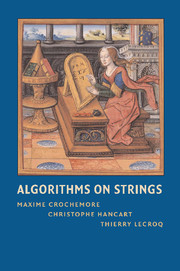9 - Local periods
Published online by Cambridge University Press: 03 October 2009
Summary
This chapter is devoted to the detection of local periodicities that can occur inside a string.
The method for detecting these periodicities is based on a partitioning of the suffixes that also allows to sort them in lexicographic order. The process is analogue to the one used in Chapter 4 for the preparation of the suffix array of a string and achieves the same time and space complexity, but the information on the string collected during its execution is more directly useful.
In Section 9.1, we introduce a simplified partitioning method that is adapted to different questions in the rest of the chapter. The detection of periods is dealt with immediately after in Section 9.2.
In Section 9.3, we consider squares. Their search in optimal time uses algorithms that require combinatorial properties together with the utilization of the structures of Chapter 5. We discuss also the maximal number of squares that can occur in a string, which gives upper bounds on the number of local periodicities.
Finally, in Section 9.4, we come back to the problem of lexicographically sorting the suffixes of a string and to the computation of their common prefixes. The solution presented there is another adaptation of the partitioning method; it can be used with benefit for the construction of a suffix array (Chapter 4).
- Type
- Chapter
- Information
- Algorithms on Strings , pp. 332 - 363Publisher: Cambridge University PressPrint publication year: 2007



